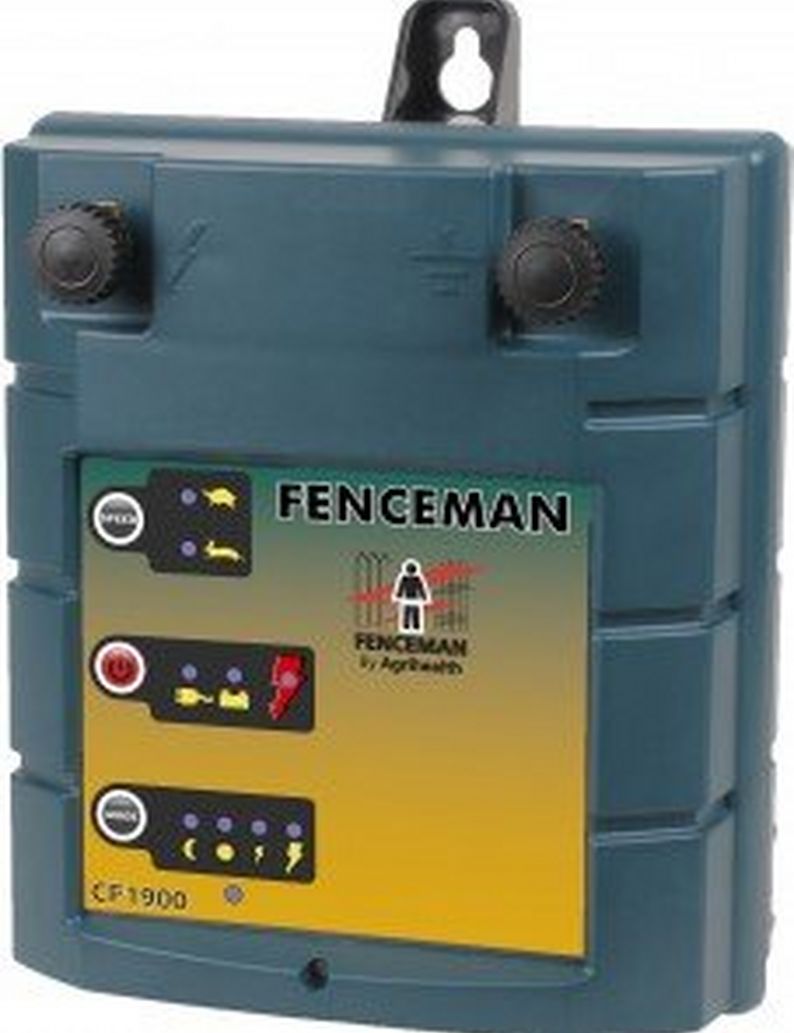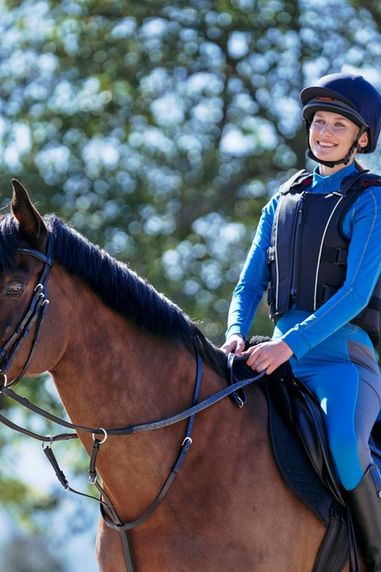
So How Does An Electric Fence Work?
The energiser generates power impulses that travel through the wires. The insulation prevents the power from being branched into the ground. The fourth component is the earthing, this should be placed deep into the ground where it is moist.
When the animal comes into contact with the fence, the circuit is closed. The current flows through the animal and soil and then back into the energiser. This is why the horse gets a shock and backs away.
What Do I Need To Set Up My Electric Fencing?
Energisers
An Energiser (or Fencer) is the device that converts mains, battery or solar power into pulses of electricity and pushes these pulses down the fence line. The stronger the Energiser the larger area the current can cover. All Fenceman Energiser have a 3 year guarantee and feature built in lightening protection.
Energisers can be split into 3 catergories:
1. Mains Energisers (M)
Mains powered energisers are cost effective to run and are usually more powerful than battery powered models. All Fencemans’ Mains Energisers supply a voltage of 230 and the energy levels range from 1.4J up to 14J.

2. Battery and Solar Energisers (B)
DP350- This energiser can operate from the included 4D cells and a 12volt battery. The energiser offers an adjustable pulse rate from 20 – 60 pulses per minute. The DP350 is suitable for strip grazing, paddocks and gardens.
B430 – This energiser is operated from a 9volt battery and offers 2 operation modes – high power and battery conserving. The B430 is highly portable, is suitable for strip grazing/paddocks and will power up to 3km single line, well insulated fencing with medium vegetation.
B860– This energiser can operate from a 9volt battery and a 12volt. The energiser offers 2 operation modes – high power and battery conserving along with fast and slow pulse rate options with Day and Night Modes. The B860 is highly portable and is suitable for strip grazing/paddocks/larger areas and will power up to 7km single line, well insulated fencing.

3. Constant Power Energisers (CP)
The Constant Power Energisers – CP450, CP900 and CP1900 – all work from a 12volt battery but include 4 internal D cells which can be used as back up power. They range from electrifing 3km of fencing with light vegetation up to 14km. All 3 energisers offer a constant power output which ensures the maximum amount of energy is available for each pulse through the lifetime of the battery.
A 3 stage battery low indicator is installed in all the CP energisers.
Stage 1 – The battery low light will flash once to let you know the battery will need changing soon.
Stage 2 – The battery low indicator will flash twice to let you know the battery needs changing.
Stage 3 – The battery low indicator will flash 3 times. If still used the battery will carry on working but there is a danger that the battery may become damaged.
CP450 – When on high power the energiser has 0.43Joules of energy and on low power 0.2J. On high vegetation can electrify 1km of fencing.
CP900 and CP1900 – The CP900 has a high power of 0.86J and a low of 0.43J and the CP1900 a high of 1.86J and a low of 1.04J.
Both energisers have a Solar option. They feature light sensors which will switch between high and low output. Night mode will put high power on at night and low in the daytime. Day mode will do the opposite and have high mode in the day and low power at night.

Batteries
6 and 9 volt batteries cannot be recharged once they have come to the end of their life. Alkaline Batteries will remain at a higher voltage for as long as possible before dropping of near the end of their life, where as Saline Batteries lose their voltage over time until they are empty.
A 9 volt battery will last approximately 12 months on a slow power and 8 months on a high. They give out around 4.3 joules of energy which is enough to power a 10 acre field.
12 volt batteries are the strongest battery option. The 12 volt leisure batteries are the better to buy, more expensive than car batteries however they have a much longer life span.

Fencing
The fencing used is purely down to personal preference and the environmental conditions of the area being used.
There are many types of fencing suitable for horses that will suit most budgets, land and requirements. Fencing should be inspected daily to make sure your horses remain safe and secure. As a guide fencing should be between 1.08m-1.38m (3.5ft-4.5ft) in height.
For temporary grazing (i.e., seasonal grazing, strip grazing), plastic fence posts are handy and they can easily be put in, moved and taken out. For more permanent fencing, many tend to go for wooden posts as they are alot sturdier.
Suitable fencing includes:
- Wooden post and rail – safe, secure and highly visible
- Stone walls – durable, natural form of shelter
- Hedges – natural form of shelter
- Plastic fencing – low maintenance and weather resistant
- Electric fencing – versatile, relatively cheap and ideal for dividing grazing
Unsuitable fencing includes:
- Plain wire
- Stock fencing (mesh)
- Barbed wire
Tape/Rope or Wire?

Tape
Fencing Tape is available in a range of colours, lengths and widths. The thicker the tape the higher the breaking strain. Tape for fencing is available in Standard Tape and High Performance Tape. The difference between the two is as follows:
Standard Tape is ideal for temporary use, it doesn’t contain much stainless steel therefore it is not a high conductor and has a low breaking strain.
High Performance Tape on the other hand contains stainless steel, tin and copper, giving excellent conductivity, breaking strain and life span. This all makes high performance tape perfect for permanent fencing.
Rope
Just like tape PolyRope is available in a range of colours, lengths and widths and ideal for use of wooden fencing as it is light. PolyRope is available in Standard and High Performance. The Fenceman High Performance Tape has a life span of around 8-10 years.
Wire
Wire is generally used more for cattle. It is not commonly used for equestrian use, as when used incorrectly can cause serious damage. If used for horses it is normally used as a deterrent to stop horses itching on the fencing.
Kits
Here at Naylors we now stock Fencing kits to get you started.
Equestrian Package
The Fenceman Equestrian Electric Fencing Package is a complete starter kit for building your own 200 metre paddock or strip of grazing. The Fenceman Equestrian Electric Fencing Package comprises of the following items to get you started:
1 x Fenceman Engergiser CP250 12v 0.25J – includes an integral earth stake, fence line, output and low battery indicator, self-supporting stand and handle
- 2 x PJ996 Batteries – non rechargeable battery suitable for the CP80, CP250 and CP500 energisers
- 20 x 35″ Fencing Posts
- 1 x 200m x 13mm Electric Fencing Tape
- 2 x End Strainers
- 1 x Warning Sign
Horse Starter Kit
The Horse Starter Kit is ideal for building the same size paddock as the Equestrian Kit. The content differs slightly:
- 1 x Fenceman Engergiser DP350B – includes an integral earth stake, uses 4D cell batteries or a 12v battery, adjustable pulse rate from 20 to 60 pulses per minute
- 4 x 4D Cell Batteries
- 10 x 35″ Fencing Posts
- 1 x 200m x 12.5mm Electric Fencing Tape
- 2 x End Strainers
- 1 x Gate Handle
- 1 x Warning Sign
Fencing Do’s & Don’ts
Do test your line with the voltmeter. It should read between 5-6000, anything less check your battery.
Do not knot your tape when extending your paddock as it damages the steel in the wire. Use a Tape Connector.
Do charge your battery on the first indicator.
Do not put your wires too close together. Keep them 5 metres apart.
Do regularly check the fence line for vegetation growing over or fallen branches, as this will reduce the voltage on the line.
Do not have your bottom wire to close to wet vegetation. Wet grass will suck juice out of the charger.
Do be generous when it comes to the grounding system for the fence. Install at least 3 galvanized ground rods 5’ deep, 10’ apart, this creates adequate ground bed for most small energizers.
Need some advice? Or do you have a question about electric fencing that we haven’t answered? Leave a comment on the blog and we’ll get back to you or alternatively contact our customer service team on 01706 507555 who will be happy to help.





